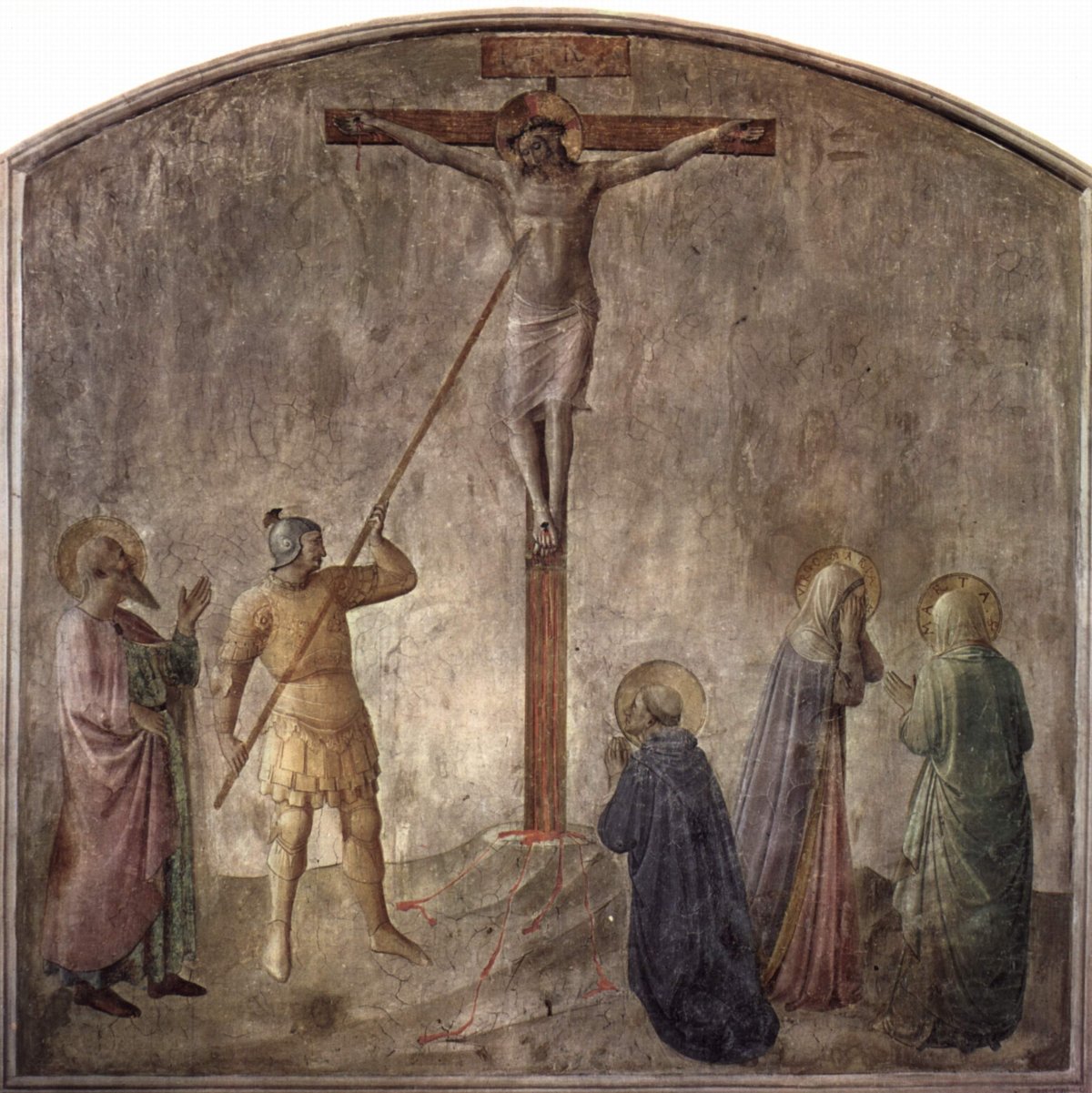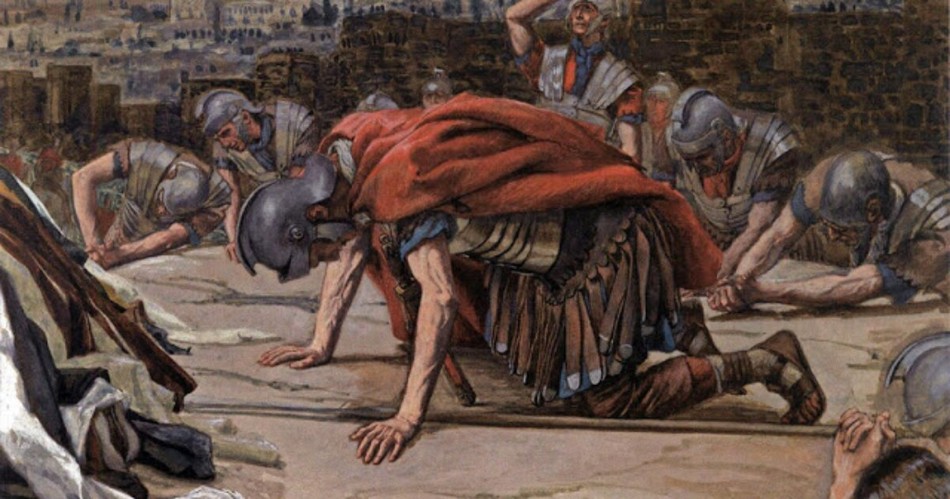Longinus is a name often associated with a figure connected to the Crucifixion of Jesus in the Christian tradition, although he is not named in the Bible itself. The story of Longinus is based on the description of an unnamed Roman centurion who was present at the crucifixion, as mentioned in the Gospels. According to the Gospel of Mark, this centurion declared Jesus to be the Son of God after witnessing the events surrounding His death.
And when the centurion, who stood there in front of Jesus, saw how he died, he said, “Surely this man was the Son of God!” (Mark 15:39)
Over time, Christian tradition named this centurion Longinus. The name first appears in the apocryphal "Gospel of Nicodemus" from the 4th century. Longinus is traditionally believed to have been the soldier who pierced the side of Jesus with a spear, an event described in the Gospel of John. This act is significant in Christian theology as it fulfills Old Testament prophecies and signifies Jesus' humanity and the redemption offered through His blood as God.
Longinus is revered as a saint in the Roman Catholic and Eastern Orthodox churches, where he is considered a convert to Christianity following his experiences at the crucifixion. His feast day is celebrated on March 15 in the Roman Catholic Church and October 16 in the Eastern Orthodox Church. The legend of Longinus and his subsequent conversion is an example of how Biblical figures can be expanded and elaborated upon in later Christian traditions despite their brief or non-specific mentions in the Bible itself.
Who was Longinus?
In the New Testament, during the crucifixion of Jesus, none of the Gospels mention the name of the Roman soldier who pierced Jesus' side with a spear. This event is recorded explicitly in the Gospel of John (John 19:34), and it serves a theological purpose by fulfilling Old Testament prophecies (e.g., Zechariah 12:10) and symbolizing the outpouring of Jesus’ blood for the salvation of mankind. The act also confirms Jesus' death, which is crucial for the doctrine of the Resurrection.
The figure known as Longinus is not named in canonical texts. His name and a more detailed story appear first in apocryphal writings, most notably in the "Acts of Pilate" or "Gospel of Nicodemus," texts that belong to the New Testament Apocrypha, written several centuries after the events of the New Testament. In these texts, Longinus is depicted as the centurion who witnessed the events of the Crucifixion and declared, "Truly this was the Son of God" (a declaration found in a similar form in Mark 15:39 from a centurion).

Origin of the Name "Longinus"
The origin of the name "Longinus" is not clearly documented. It may derive from the Latin "longus," meaning "long," possibly a reference to the spear used to pierce Jesus’ side. This name could have been retrospectively applied to the centurion in an attempt to give a specific identity to a poignant figure in the Crucifixion narrative.
Over centuries, the figure of Longinus evolved in Christian lore. By the Middle Ages, Longinus was venerated as a saint, and his story expanded to include his conversion to Christianity, his martyrdom, and miracles associated with relics attributed to him, like the Holy Lance, also known as the Spear of Destiny, which he purportedly used to pierce Jesus.
Longinus in the Gospel of John
"But one of the soldiers pierced His side with a spear, and at once there came out blood and water." John 19:34 is a short yet theologically significant verse in the Gospel of John. It narrates a critical moment during the crucifixion of Jesus, where a soldier pierces Jesus' side with a spear, causing a sudden flow of blood and water. This event occurs after Jesus has been declared dead, serving several crucial purposes within the narrative and Christian theology.
This event is reported solely in the Gospel of John. The context is Jesus' crucifixion, where, to expedite the deaths of the crucified before the Sabbath, the Roman soldiers break the legs of the other men crucified with Jesus. However, when they come to Jesus, they find him already dead and refrain from breaking his legs. To confirm his death, one of the soldiers pierces his side.
The Spear of Longinus
The Spear of Longinus, also known as the Holy Lance, is believed to be the spear that a Roman soldier used to pierce the side of Jesus during his crucifixion. This spear is significant in Christianity because it was involved in a crucial moment of Jesus' life and death and is thought to have particular spiritual importance.
The spear's use to pierce the side of Jesus as he hung on the cross directly ties it to the most critical moment in Christian theology—the crucifixion. This act is seen as a fulfillment of prophecy and a confirmation of Jesus’ humanity and death. It underscores the reality of Jesus' sacrifice, emphasizing that he indeed suffered and died for the sins of humanity.
He himself bore our sins in his body on the tree, that we might die to sin and live to righteousness. By his wounds you have been healed. (1 Peter 2:24)
But he was pierced for our transgressions; he was crushed for our iniquities; upon him was the chastisement that brought us peace, and with his wounds we are healed. (Isaiah 53:5)
The act of not breaking Jesus' legs and the piercing of his side are seen as fulfillments of Old Testament prophecies, linking Jesus' death directly to scriptural predictions. John mentions explicitly these fulfillments:
The legs not being broken fulfills Exodus 12:46 and Numbers 9:12 concerning the Passover lamb, a type of Christ.
The piercing fulfills Zechariah 12:10: "They will look on the one they have pierced," which John explicitly cites shortly after the verse in question (John 19:37). This prophecy links Jesus with the suffering servant of Jewish scriptures, thereby emphasizing his role as the savior.
The flow of blood and water from Jesus' side has profound sacramental and symbolic meanings:
Eucharistic Symbolism: The blood can symbolize the Eucharist, representing the new covenant between God and humanity through Jesus’ sacrifice.
Baptismal Symbolism: The water complements this by symbolizing baptism, which in Christian doctrine is associated with the purification of sins and the new birth into a life with Christ.
Ecclesiological Interpretation: Early Church Fathers like Augustine viewed the outflow of blood and water as metaphorically representing the Church itself—born from the side of Christ, just as Eve was created from the side of Adam. In this sense, the spear that inflicted the wound also symbolically participates in the birth of the Church, marking it as a tool used in the divine plan for humanity's salvation.
In the broader narrative structure of John's Gospel, the piercing of Jesus' side emphasizes his true humanity (he is physically dead) and his divinity (his death fulfills divine prophecies and carries redemptive power). The incident also underscores the Gospel's themes of witness and testimony—here, the soldier (Longinus) unwittingly testifies to the reality of Jesus' mission and his identity as the Son of God through this act.
The Legacy of Longinus
In conclusion, while the figure known as Longinus is not explicitly named in the Bible, his legacy is deeply embedded in Christian tradition through the pivotal role he is believed to have played during the crucifixion of Jesus. Identified as the Roman soldier who pierced Jesus' side, Longinus' actions fulfill key scriptural prophecies and hold significant theological import, particularly in the symbolism of the blood and water that flowed from Jesus.
Although the historical details about Longinus are sparse and largely derived from apocryphal texts and later Christian lore, his story encapsulates the transformative power of witnessing Christ's passion. This makes Longinus not just a peripheral biblical figure, but a central character in the narrative of faith, conversion, and the profound mysteries of Christ's death and its redemptive power in Christian theology.
Christianity.com's editorial staff is a team of writers with a background in the Christian faith and writing experience. We work to create relevant, inspiring content for our audience and update timely articles as necessary.
This article is part of our People of Christianity catalog that features the stories, meaning, and significance of well-known people from the Bible and history. Here are some of the most popular articles for knowing important figures in Christianity:
How Did the Apostle Paul Die?
Who are the Nicolaitans in Revelation?
Who Was Deborah in the Bible?
Who Was Moses in the Bible?
King Solomon's Story in the Bible
Who Was Lot's Wife in the Bible?
Who Was Jezebel in the Bible?
Who Was the Prodigal Son?




